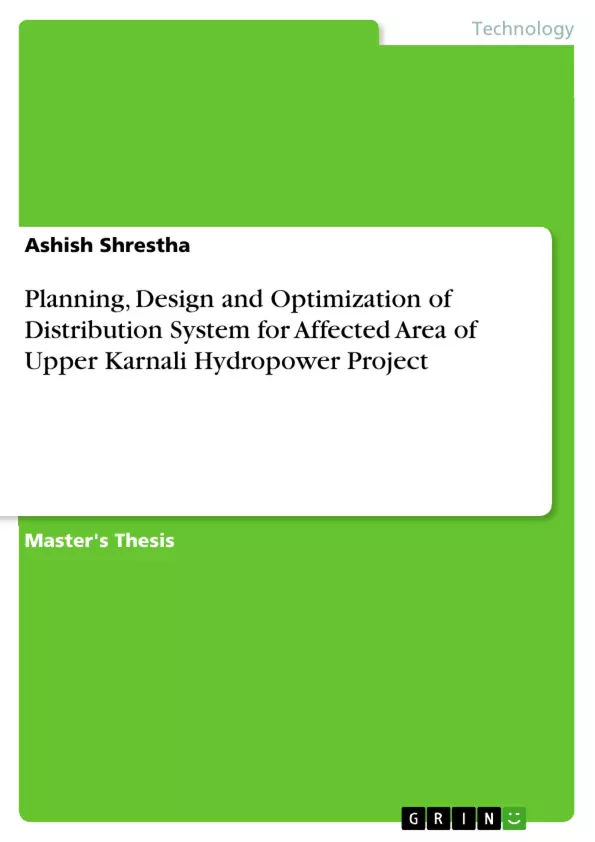This study illustrates the best approach for energy access to the affected area of a 900 MW Upper Karnali Hydropower Project (UKHPP) located in Western Nepal. As per concession agreement executed between the developer of UKHPP and the Government of Nepal, the developer will develop 2 MW power plant at the toe of the dam using the environmental release discharge to electrify the affected area of UKHPP. First, the study looks at the optimization of the electric grid network in the project affected area, using Kruskal’s algorithm. The optimization is carried out so that access to electricity is guaranteed to possible load centers in the affected area to the extent possible in technical and financial feasible manner. This study is an attempt to connect the possible load centers through an optimum network design based on demography, topography, technical feasibility and socio-economic factors. The study focuses on the design of the electrical network based on a least distance path between the identified nodes. The designed network is based on the survey using GIS, Topographical maps, and satellite views from Google map. A total of 57 load centers are identified connected through a grid 144.59 km in length. Similarly, taking n=4 sample, the total length of 220V distribution system is estimated to be 417.24 km.
After that, the study focuses on the Static Load Flow Analysis (SLFA) by developing a framework based on Conventional Newton- Raphson method to analyze the network’s parameters. The result obtained from the analysis is compared with the results of standard 33-bus radial feeder system and forward/backwards (f/b) sweep based algorithm using statistical analysis. The standard error is accepted for the 95% level of significance. It is concluded that, the load flow analysis (LFA) of the primary distribution in this study conducted using the N-R method was adequate and best fit for a grid-like network with medium voltage level. The estimated losses are low and under the limit (i.e. 2.04%) which shows that the designed system performs adequately. From the analysis, it is found that, the pre-defined generation of 2 MW power is insufficient to electrify the whole affected area of the UKHPP. Different alternative ways are recommended to manage the load and provide electricity to the people of the affected area.
Inhaltsverzeichnis (Table of Contents)
- CHAPTER 1: INTRODUCTION
- 1.1 Project Background
- 1.2 Upper Karnali Hydropower Project (UKHPP)
- 1.3 Research Questions
- 1.4 Research Objectives
- 1.5 Research Approaches
- 1.5.1 Phase One
- 1.5.2 Phase Two
- 1.6 Scope and Limitations of the Thesis
- CHAPTER 2: FUNDAMENTALS OF DISTRIBUTION SYSTEMS
- 2.1 Types of Distribution Systems
- 2.1.1 Classification based on nature of current
- 2.1.2 Classification based on construction
- 2.1.3 Classification based on the arrangement
- 2.1 Types of Distribution Systems
- CHAPTER 3: SELECTION OF OPTIMAL DISTRIBUTION SYSTEM
- 3.1 Required Data and Assumptions
- 3.2 Selection of Load Center and Grid Network
- 3.3 Selection of Grid Network
- 3.3.1 Algorithm for Kruskal's algorithm
- 3.3.2 Flow Chart for Kruskal's algorithm
- 3.4 Optimized Grid Network
- 3.5 Voltage level Selection
Zielsetzung und Themenschwerpunkte (Objectives and Key Themes)
This dissertation investigates the optimal approach to providing energy access to the affected area of the Upper Karnali Hydropower Project (UKHPP) in Western Nepal. The study focuses on optimizing the electrical grid network in the project-affected area using Kruskal's algorithm, analyzing the network's parameters through Static Load Flow Analysis, and evaluating the feasibility of the proposed 2 MW power plant to meet the region's energy needs.
- Optimization of electrical grid network in the project-affected area
- Design of the electrical network based on a least distance path
- Static Load Flow Analysis of the network
- Evaluation of the adequacy of the 2 MW power plant
- Recommendations for alternative solutions to manage load and provide electricity
Zusammenfassung der Kapitel (Chapter Summaries)
- Chapter 1: Introduction This chapter provides the background of the UKHPP project and the need for electrification in the affected area. It outlines the research questions, objectives, and approaches employed in the study, including the two-phased approach. The chapter also addresses the scope and limitations of the thesis.
- Chapter 2: Fundamentals of Distribution Systems This chapter explores various types of distribution systems, classifying them based on the nature of current, construction, and arrangement. This provides a foundational understanding of the different distribution system configurations.
- Chapter 3: Selection of Optimal Distribution System This chapter focuses on selecting the optimal distribution system for the UKHPP affected area. It outlines the data and assumptions used, the process of selecting load centers and grid networks, and the application of Kruskal's algorithm to optimize the grid network. The chapter also discusses the selection of the appropriate voltage level for the system.
Schlüsselwörter (Keywords)
This dissertation explores key topics related to the planning, design, and optimization of a distribution system for the affected area of the Upper Karnali Hydropower Project (UKHPP) in Western Nepal. It encompasses research areas like Kruskal's algorithm, static load flow analysis, and network optimization. The study aims to provide a comprehensive understanding of the challenges and opportunities associated with electrifying a remote region, considering factors like demography, topography, technical feasibility, and socio-economic conditions.
- Quote paper
- Master Ashish Shrestha (Author), 2017, Planning, Design and Optimization of Distribution System for Affected Area of Upper Karnali Hydropower Project, Munich, GRIN Verlag, https://www.grin.com/document/378772



